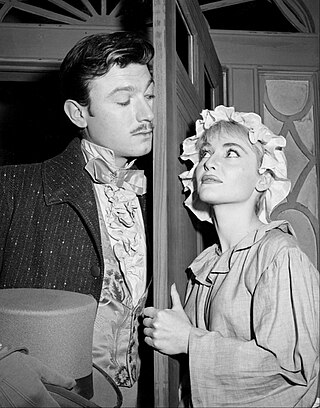Top Qs
Timeline
Chat
Perspective
The Alcoa Hour
American TV dramatic anthology series (1955–1957) From Wikipedia, the free encyclopedia
Remove ads
The Alcoa Hour is an American anthology television series sponsored by the Alcoa Corporation that aired live on NBC from October 16, 1955, to September 22, 1957.[1]
Remove ads
Overview
The Alcoa Hour is a one-hour live anthology series that primarily presented dramas but occasionally presented a musical[1] or a comedy.[2]
The series alternated weeks in the same time slot with the Goodyear Television Playhouse until both series ended in 1957.[3]
Notable episodes
Summarize
Perspective
The series's premiere episode, The Black Wings, marked the American TV debut of Ann Todd.[1]
The show garnered press in February 1956 for actor Lloyd Bridges's emotional performance in an episode titled "Tragedy in a Temporary Town", directed by Sidney Lumet.[4] During the performance, Bridges inadvertently slipped in some profanity while ad-libbing.[5] Although the slip of the lip generated hundreds of complaints, the episode won a Robert E. Sherwood Television Award, with Bridges's slip defended by many, including some members of the clergy.[5][6][7] The episode, during which an innocent Puerto Rican man is targeted by a mob for a sexual crime, was cited by the Anti-Defamation League as "the best dramatic program of the year dealing with interethnic group relations".[6]
One episode was the telecast of The Stingiest Man in Town, a musical adaptation of Charles Dickens's A Christmas Carol, starring Basil Rathbone, Johnny Desmond and Vic Damone.[1] It is the only Alcoa Hour production to be granted an original cast album recording. The Stingiest Man in Town was remade in 1978 as a Rankin-Bass animated cartoon featuring the voice of Walter Matthau as Scrooge, and was also sponsored by Alcoa.[citation needed] Another record album, The Magic Horn (Victor LPM-1332), was "not the soundtrack, but largely a re-creation of the music that was played" on the show's episode "The Magic Horn".[8]
Remove ads
Episodes
Summarize
Perspective
Series overview
Season 1 (1955-56)
Season 2 (1956-57)
*No information found for this episode.
Remove ads
Production
Herbert Brodkin was the producer. During his 12-week vacation in 1956, associate producer Philip Barry Jr. produced the series.[12] Its first color episode was broadcast on April 19, 1956, from NBC's Brooklyn studio.[2]
The trade publication Billboard reported in September 1956 that the budget for the Alcoa-Goodyear program had been increased to an estimated $65,000 per production for the upcoming season. It had been $45,000 during the previous season. The extra funding was said to allow the shows to "go in more for established properties which have greater exploitation possibilities to awaken audience interest".[13]
Remove ads
Critical response
Jack Gould, writing in The New York Times, commended the presentation of "The Big Wave" as one that "added further luster to the Alcoa Hour".[14] He commended the director's and producer's conveying the story "to the home screen with deeply understanding fidelity", and noted that the episode "was one of the most rewarding programs yet seen" for viewers who had color receivers.[14]
In contrast, The Times called the series's final episode, "Night", "a pointless and offensive exercise in violence and inanity". The brief review ended with, "There was no excuse at all for this one."[15]
Remove ads
See also
References
External links
Wikiwand - on
Seamless Wikipedia browsing. On steroids.
Remove ads

